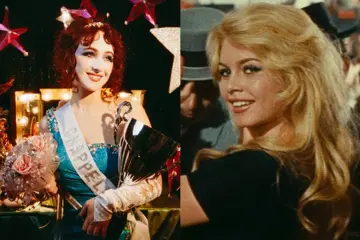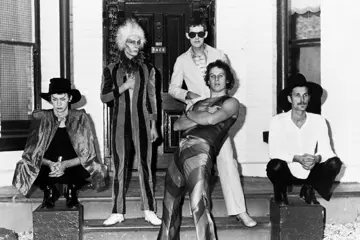 Sam Smith
Sam SmithAs the annual headline-generator that is the Grammys wrapped up earlier this week, pop musicians Sam Smith and Kim Petras found themselves at the centre of post-ceremony discourse. Not for the quality of their Best Pop Duo/Group Performance-winning track Unholy, or the traditional queerphobia that follows them, but rather, for accusations of satanism.
Donning red outfits, with Petras in a cage, and Smith in a horned top hat, the duo were joined by dancers as they appeared to contextualise the very nature of their chart-topping song.
Hollywood freaks still thinking they’re so edgy with their Satanic themed performances 🤡🤡🤡 #GRAMMYs #kimpetras #SamSmith pic.twitter.com/6IyL8YYFdt
— Stephanie Hamill (@STEPHMHAMILL) February 6, 2023
A fitting performance, some of the nuance appeared to have been lost on the conservative media, with the likes of US Senators Ted Cruz and Majorie Taylor Greene labelling the performance as “evil” and “demonic”, respectively, and Fox News host Tucker Carlson calling it “transgender satanism”.
For what it’s worth, the Church of Satan was less than impressed, with magister David Harris telling TMZ the performance was “nothing particularly special”.
Don't miss a beat with our FREE daily newsletter
But this modern-day moral panic is nothing new, and as Harris infers, it’s nothing special. In fact, none of the musical incidents that have inspired a resurgence of the ‘satanic panic’ have ever been more than a storm in a teacup.
satanic panic stuff is wild because you have one side being like "don't you understand symbolism and art, even a little bit, even conceptually?" and the other side responding "no, absolutely not even a little"
— Law Boy (@The_Law_Boy) March 29, 2021
Let’s rewind briefly to look at the origins of the satanic panic. Though fears of satanism are as old as the very concept itself, it was in the ‘80s that the modern-day panic came to light. In 1980, authors Lawrence Pazder and Michelle Smith (who began their relationship as psychiatrist and patient, respectively, before marrying) published Michelle Remembers, which spoke of recovered-memory therapy and Smith’s claims of satanic ritual abuse.
Though later discredited, the book’s impact was felt far and wide (though mainly throughout North America), and was used as ostensible ‘proof’ of satanism and its pervasive impact on the population.
Before long, issues of satanism had spread elsewhere, with rock and heavy metal music swiftly shouldering the spotlight due to its harsher sounds, performative flamboyant nature, and alleged link to, and worship of, satan. In 1985, Tipper Gore, the wife of future US Vice President Al Gore, founded the Parents Music Resource Center, a committee which aimed to increase parental control over popular music.
Inspired by Gore’s discovery of explicit lyrics on Prince’s Purple Rain album, the committee launched a campaign which aimed to label any albums that contained offensive content with stickers that informed consumers of the themes contained therein. The committee would ultimately be successful in their campaign, resulting in the parental advisory stickers that adorn albums to this day.
However, while the opposing side featured verbose speeches from the likes of Frank Zappa, Twisted Sister’s Dee Snider, and even John Denver, a music professor from the University of Texas would go on the record to support the committee’s efforts, noting heavier music had principal themes of “violence, extreme rebellion, substance abuse, sexual promiscuity and perversion and Satanism”.
While the average music fan would have found the concept laughable, this academic viewpoint only helped to strengthen the view of satanism in the eyes of the general public.
At the same time as the PMRC’s campaign, the more conservative factions of the world found themselves growing increasingly concerned at the notion of backmasking. The idea that subliminal messages had been placed within popular music, only to be heard when played backwards, was not a new one, with The Beatles having been accused of such practices in the ‘60s in connection to the ‘Paul is dead’ conspiracy.
Famously, the likes of Led Zeppelin’s Stairway To Heaven allegedly contains a satanic message, though the average listener would likely agree it’s no more than the power of suggestion at play, with those specifically searching for satanic messages more likely to find such phrases than otherwise.
Nevertheless, the outrage was notable, with a fundamentalist Christian pastor in the US going so far as to inspire a mass destruction of records in response to the growing danger of backmasking.
It wasn’t until 1990 that backmasking became a widespread fear, however, and it wasn’t the likes of noted troublemakers Ozzy Osbourne or KISS (who themselves had been rumoured to have adopted their moniker as an initialism of ‘Knights In Satan’s Service’) who inspired the panic, but rather Judas Priest.
Famously, the English metal outfit were sued over the deaths of friends James Vance and Raymond Belknap. Belknap died at age 18 in 1985 of a self-inflicted gunshot, and Vance, aged 20 at the time, would pass away three years later after being disfigured in the initial incident. The lawsuit claimed that after listening to Judas Priest’s cover of Spooky Tooth’s Better By You, Better Than Me from their 1978 album, Stained Class, the pair had been inspired to kill themselves.
Lawyers claimed that the song in question contained phrases such as “let’s be dead”, “try suicide”, and “do it” when played backwards, while Vance’s parents claimed that his Christian faith had been changed due to the “garbage music” of Judas Priest. Though the lawsuit was dismissed by a judge who labelled the alleged message as “coincidental”, frontman Rob Halford later claimed the idea of inserting subliminal messages wasn’t cohesive to the band’s business, noting he’d rather insert phrases that urged fans to “buy more of our records”.
The satanic panic was again revived throughout the ‘90s thanks to shock-rockers such as Marilyn Manson, who gained notoriety for albums such as 1996’s Antichrist Superstar, and was protested at almost every North American stop of their accompanying ‘Dead To The World Tour’. Claims of “bestiality, satanic altars, ritual rapes and the distribution of free drugs” at these concerts were levelled by conservative groups, with their fears only increased when Manson was scapegoated as an apparent cause of the Columbine High School shootings in 1999.
MSCHF x Lil Nas X "Satan Shoes" 🏹
— SAINT (@saint) March 26, 2021
👟Nike Air Max '97
🩸Contains 60cc ink and 1 drop of human blood
🗡️666 Pairs, individually numbered
💰$1,018
🗓️March 29th, 2021 pic.twitter.com/XUMA9TKGSX
However, such is the case that widespread fear will follow when any artist who bucks trends and diverts from the norm rises in popularity, the satanic panic once again reared its ugly head in 2021 when Lil Nas X, himself a queer person of colour, attempted to sell shoes in conjunction with his single Montero (Call Me By Your Name).
Created in partnership with US art collective MSCHF, the shoes in question were modified versions of Nike Air Max 97s and dubbed Satan Shoes. Coloured in red and black, paired with a pentagram, and limited to 666 copies, the shoes gained media attention for their soles containing a drop of human blood from the MSCHF team.
As expected, the $1,000+ shoes sparked controversy from conservative commentators, with many condemning both Lil Nas X and Nike, and targeting the singer for satanism rather than reasons of race and sexuality for a change.
“I hope Nike burns to the ground and goes bankrupt over this,” wrote US pastor George Locke. “First they use massive amounts of child slaves and now they openly promote Satanism. Disgusting.”
“Our kids are being told that this kind of product is, not only okay, it's ‘exclusive’,” added US Governor Kristi Noem. “But do you know what's more exclusive? Their God-given eternal soul.”
Lil Nas X himself responded to claims that he was corrupting the youth by placing the blame on parents. “i literally sing about lean & adultery in old town road,” he Tweeted in March 2021. ”u decided to let your child listen. blame yourself.”
Notably however, the biggest controversy relating to the shoes was the lawsuit which followed, with Nike suing Lil Nas X due to unauthorised use of their famous ‘Swoosh’, and claims that consumers would assume they were involved in their manufacture.
However, if history has told us anything in regards to these moral and satanic panics, it’s that as long as cutting-edge artists continue to push boundaries and exercise their creative control in new and exciting ways, conservative mouthpieces will forever find a way to raise concern, and a reference to satanism will likely follow.
But for those wrapped up in the current controversy, one needn’t worry, with even the Church of Satan’s David Harris claiming in his recent interview that Lil Nas X’s video for Montero (Call Me By Your Name) was much more provocative than Sam Smith and Kim Petras. Seems like they’re still fighting the wrong battle.















